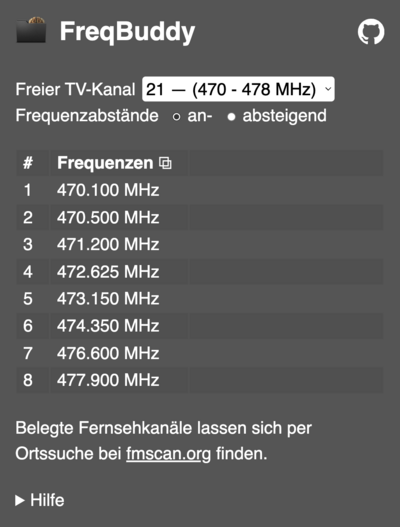Table of Contents
FreqBuddy
- name:
- FreqBuddy
- project-owner:
- Simpel
- git-url:
- https://github.com/SimpelMe/freqbuddy
- project-description:
- Get the best 8 interference-free frequencies (UHF) within a TV channel.
- project-member:
- @@project member@@
- project-status:
- in production
How it works
This tool calculates the best interference-free radio frequencies (UHF) within a TV channel (8 MHz grid). Only one TV channel is analyzed in isolation. Additional frequencies from other TV channels are not checked for compatibility.
Important note
FreqBuddy is designed for use in Germany. Even if the TV channels are not only used in Germany, the exclusions (radio astronomy and LTE) are adapted to German conditions. Other comments are also applied exclusively to German rules.
Attention: FreqBuddy is a mathematical tool for calculating optimal frequencies. You must check for yourself whether the use of these frequencies is permitted for your application.
Tip
First use fmscan.org to find out which TV channels (column “Ch”) are not or only weakly occupied by DVB-T. Completely free channels do not appear in the list and are probably a good choice. Ideally, do not use two directly adjacent TV channels.
Other functions
- Click on a single frequency to show it in full screen.
- Click on the copy symbol (⧉) to the right of the table heading to copy the entire table to the clipboard.
- Cookie: The last TV channel selected (and the frequency intervals selected in ascending or descending order) are saved in a cookie for 7 days.
Backgrounds / details
Frequency intervals
These can be mirrored within a TV channel. By default, the spacing increases with each higher frequency (increasing - ↑). This can be reversed (descending - ↓). This is recommended, for example, for a second set of frequencies to be used simultaneously. The second set should be as far away as possible from the first and use the descending frequency spacing instead of the ascending one.
Antenna spacing
If the transmitter and receiver are to be operated close to each other:
- The physical distance between the antennas of the transmitter and receiver should be as large as possible.
- Transmitter and receiver should be at least 8 MHz (one TV channel) apart to minimize transmitter-receiver blocking.
Background frequencies
- A maximum of 8 frequencies are available in one TV channel.
- TV channels close to LTE have fewer frequencies available due to the protection gap.
- With decreasing frequency spacing (↓), the number of usable frequencies for these TV channels decreases again.
- Handheld devices in the frequency range 823 - 826 MHz may only be operated with a maximum transmission power of 82 mW.
Calculation of the freedom from intermodulation
- min. 400 kHz carrier spacing
- min. 200 kHz spacing 2TX-IM(3) - 3rd order intermodulation of 2 transmitters
- min. 100 kHz spacing 3TX-IM(3) - 3rd order intermodulation of 3 transmitters
- Intermodulation strength: F1: 54 %, F2: 65 %, F3: 49 %, F4: 67 %, F5: 81 %, F6: 63 %, F7: 82 %, F8: 66 % (The higher the percentage, the better the signal.)
The minimum requirements for intermodulation resistance are met in all cases. These values apply to the increasing frequency intervals. The order must be reversed for the descending frequency intervals.
